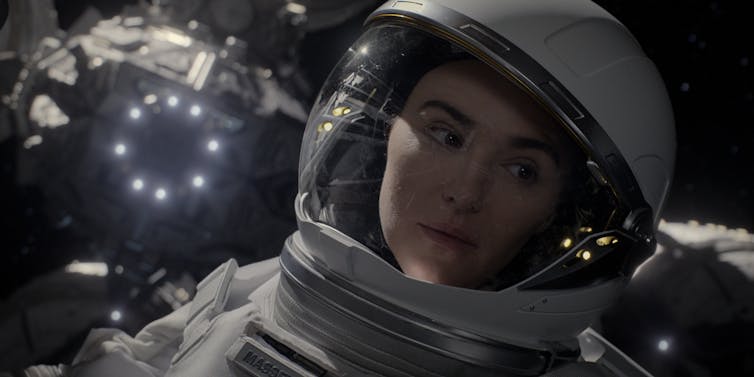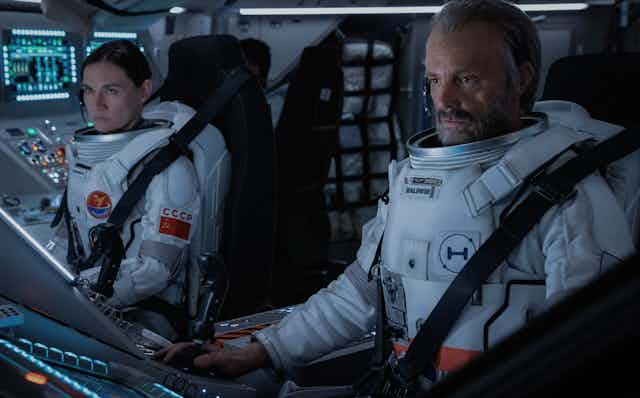Great art is often difficult to quantify. Apple TV’s series For All Mankind is a case in point, running the risk of being too sci-fi for drama fans (rockets, moon bases, Mars) and having too much naturalistic drama for sci-fi aficionados (jealousy, divorce, institutional politics).
Nonetheless, the show consistently rewards both sets of viewers by brilliantly blurring the line between reality and alternate history. It tells a compelling story wherein the Soviet Union beat the US to land on the Moon and, consequently, the space race never ended.
For All Mankind begins in an Apollo era transformed by the inclusion of women, characters of colour and LGBTQ+ protagonists. The show moves through the creation of long-term lunar habitation in the 1980s and, eventually, crewed landings on Mars in the mid-1990s – with all the downstream technological benefits that implies (electric cars in the 1980s, anyone?).
The upcoming fourth season promises to explore the implication of humanity’s first steps on the red planet, adding a focus on extractive industries and energy politics to the show’s longstanding interrogation of American Manifest Destiny – the idea that God intended the US to spread democracy and capitalism across the world. Jamestown, the US lunar base, deliberately echoes the first permanent Anglo colony in the Americas, for example.
Yet, For All Mankind’s defining trait is scrutinising how the foibles of individuals can make or break a whole civilisation’s journey to the stars. Its powerful message is that the most mission-critical systems of all are human beings and their interpersonal relationships, which is an excellent lesson for storytellers.
Astronaut fiction
For All Mankind mines a rich vein of astronaut screen fiction, starting with the now-forgotten black-and-white TV show Men Into Space (1959). That series anticipated many of the elements which For All Mankind would later double down on, such as women astronauts, realistic technical challenges and the search for water on the Moon.

In their 1960s and 1970s heyday, of course, astronauts were everywhere. Science and fiction blurred in countless pulp tales, B-movies, magazine features, novels and comics. Even a space-suited Barbie debuted four years before a man would walk on the Moon. David Bowie sang about a “space oddity” in 1969 (later covered by astronaut Chris Hadfield, who filmed the first music video in space), while in 1977, Star Trek actress Nichelle Nichols was tasked by Nasa with recruiting a more diverse field of astronaut candidates.
More recent forerunners of For All Mankind include Apollo 13 (1995) and its magnificent companion TV series, From the Earth to the Moon (1998). Then there are the blockbusters like Ridley Scott’s The Martian (2015) and the visually stunning Gravity (2013). Hidden Figures (2016) dramatised the real-life history of Nasa’s African-American women mathematicians, who overcame discrimination to contribute greatly to America’s earliest space missions.
Nixon’s women
While building upon all of these, For All Mankind stands out – like Hidden Figures – for its willingness to deconstruct the myth of the straight white male flyboy. That character is here personified by the temperamental Ed Baldwin (Joel Kinnaman) and the upward-failing father and son astronauts Gordo and Danny Stevens (Michael Dorman and Casey W. Johnson).
The stereotypical all-American hero, the show says, is likely prone to anger-management issues, substance abuse and infidelity. In their place, the series uses an alternate history to reconstruct a better, more inclusive and even more diverse vision of Nasa.
In the third episode of season one, set in the 1970s, Nasa seeks to counter Russia’s landing of a woman on the moon by recruiting women pilots of its own. These characters are known as “Nixon’s women”. Among them is the deceptively quiet Ellen Waverly (Jodi Balfour), former Nasa “computer” Danielle Poole (Krys Marshall), and the barnstorming Molly Cobb (Sonya Walger). They quickly become central protagonists in humanity’s interplanetary expansion.
While the show usurps Sally Ride’s distinction as the first American woman in space, it compensates by making its fictionalised Ride (Ellen Wroe) a moral heavyweight during a Cuban Missile Crisis-style lunar standoff.
Yet, even in this timeline, some things remain the same. In the third season, a gay astronaut comes out in a broadcast from the surface of Mars, only to find that historical prejudice has followed him to another planet. His openness inadvertently inspires the creation of the Don’t Ask, Don’t Tell military policy. But the difference here is that For All Mankind’s US president is themself a closeted character, who must reach a difficult personal and political reckoning with this policy.
Their resulting ethical quandary is played with the acute introspection of literary drama, but their story – a cognitive estrangement asking us to look anew at our own history – is enabled by the narrative apparatus of science fiction. It encapsulates what makes For All Mankind potentially the greatest show on television right now: meaningful human tales told against an interplanetary backdrop.

Looking for something good? Cut through the noise with a carefully curated selection of the latest releases, live events and exhibitions, straight to your inbox every fortnight, on Fridays. Sign up here.

